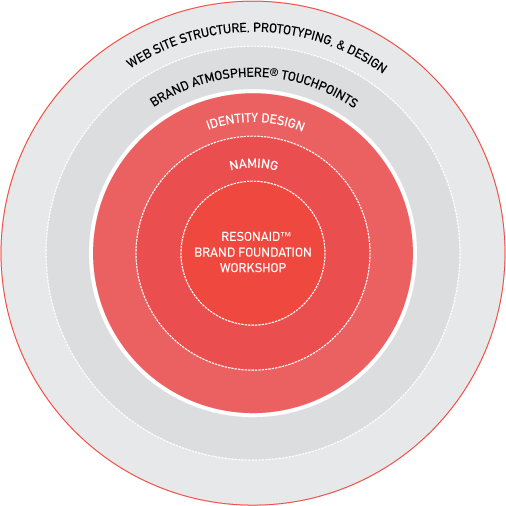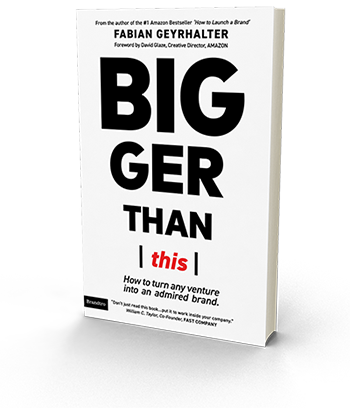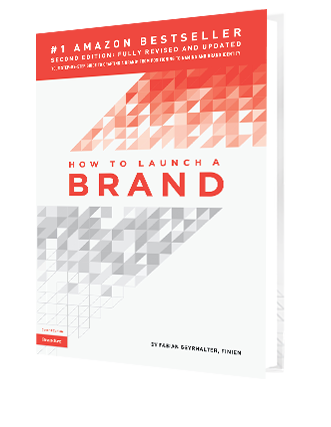Startup Advice
Don’t Give The Customer What She Wants
Your new brand is not yours, it is your customer’s. Then let’s give the people what they want. Sounds rational, but it’s not that easy.
People do not know what they want when it comes to new brands. We do not know how to venture into the unknown with brands, we tend to seek comfort only in the familiar, and the familiar is far from aspiration or disruption. To look ahead and to launch something new you need to charter into the unknown.
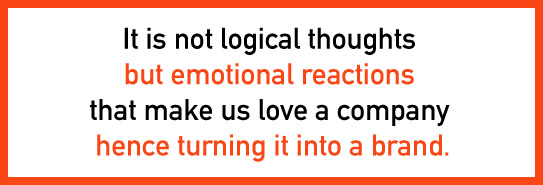
A client shared with me the other day, that they will test two variations of their new brand in an A/B test with their audience prior to deciding which they should actually go with. From an analytics point of view it makes total sense: test two brands (the logo, look & feel, voice Etc) with the audience and see which one they prefer. Yes you will confuse some, but heck, worth the data.
I strongly advised against it.
The problem is that branding is far removed from analytics. It is not logical thoughts, but emotional reactions that make us love a company or product, hence turning it into a brand. Further, befriending and adapting a new venture as a brand happens over time. Yes, you will immediately know if you need the product, you might even decide you want the product, but to fall in love with the brand, that does not happen in an instant, not in an A/B test, and, you very well may disagree with me on this, not in a focus group.
Do you think a white swoosh on bright red is a good solution for a new sugary caramel/caffeine syrup-based soft drink? Nah, we would all rationally agree that beige bubbles would visually translate the taste much better. Done. Death of the Coca-Cola brand by committee.
Brand creation by committee is not the solution. Brand creation through A/B tests is not a guarantee for success (but a sure way to confuse customers and staff). Brand building based on a solid brand strategy (research and insights) mixed with honest gut feelings is the formula for success, and for that to happen it takes a founder’s complete trust in her brand consultant and herself, as well as a boatload of courage. This might just be the reason why you see so many focus groups and A/B tests.
Rapid-Fire Brand Name Advice
On this blog I already talked about what makes a name successful and how to pick a domain name, but many of you ask if I find a fabricated name to be superior to a descriptive name, and how to best navigate the types of names that one can consider, quickly. Short and actionable, I’ll give one sentence of advice on each type of name. 3, 2, 1, go:
Descriptive
Example: Match.com
Advice: Great as it immediately conveys what it is/does – only if you will never expand your product offerings – but limiting and hard to find a sound domain name
Metaphor
Example: Puma
Advice: Not a top choice as existing connotations, domain name difficulties and Search Engine results can quickly come in the way for a new company
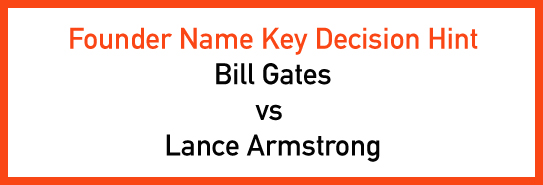
Founder
Example: The Bill & Melinda Gates Foundation
Advice: Great if you are the brand, you already have a legacy and if you are Bill, and not Lance
Fabricated
Example: FINIEN
Advice: It’s genius, of course! In all seriousness, it is a great path, if easy to pronounce and recall, and backed by a great story
Acronym
Example: AOL (America On-Line, Remember?)
Advice: A solid option to sound like a larger company from the start; only if your customers can recall your letters and if you can get hold of a reasonable domain name (sorry, three- or four-letter combos are all sold out)
Fabricated x Acronym
Example: Wanelo (Want, Need, Love)
Advice: Great option if tied to a tag line – otherwise the same criteria applies as with Fabricated names
Creative Spelling
Example: Lyft
Advice: Don’t do it, it’s pure laziness – unless word of mouth is not important to you (Wait, you spell it just like Supply but with a v instead of the u?) and you cater solely to ages 18-28
Numeric
Example: 7-Eleven
Advice: Don’t do it out of laziness (I picked our street number, easy does it) as no one will recall it – do it only if you can create shared meaning (7-Eleven: open 7 – 11, 7 days a week) or showcase value (Social 123 – easy as 1-2-3). See my post on numeric names for details.
There you go – no more excuses. Just do it, or dig deeper via our white paper, or if all fails (or you have better things to do, like starting a business) call me for help, or call us for hands-on naming magic.
CATEGORIES: Startup Advice Your Brand Launch: Naming
Your New Company’s ‘Stick’ – When Branding Helps Create And Save Your Venture
Ask yourself: Am I about to launch a product/service, or a brand?
How would you know?
You may not have a direct competitor yet, but you soon will. When the innovative, new and unique wears off, competitors will offer your product at a lower cost. How will you keep your customers from choosing their product instead? What will it be that will make your offering stick? Too many startups have to re-invent, re-brand and re-connect once they find traction – at a high cost.
If you have a unique offering combined with ‘the stick’ – the set of true differentiators, the emotional connectors that deliver from the inside out, consistently on message (visually and verbally) and on target – you know you have a brand. Having that foundational special ingredient is like a survival formula for your startup, it will make customers come sooner, faster and stay around even if they could save a few bucks elsewhere later on.
@i_mdoughboy tweeted the following last week about my consultancy’s process chart (see below): Guess where the value is? Here’s a hint – the graphic is eerily similar to a bullseye.
Imagine you are a gifted craftsman that has mastered a unique design that you developed over the course of years just to sell very few and at a high price as you don’t have the audience nor infrastructure. You created something truly unique that only you offer. After years of work, but only a few units sold, you see your design offered at a fraction of the cost at a large retail chain. It happens daily. Examples are too many to give, from apps to shoes to frozen yogurts, and all across B2B services. The only real life insurance you can have, besides a unique product/service to start out with, and its correlating trademarks, is to have that ‘stick’, those emotional brand differentiators that spread across product, service and your Brand Atmosphere. Those are hard to replicate.
If they like your product/service, they might come and purchase it.
If they love your brand, they will come and purchase it, return to it, and stay with it.
(Only read further if this hits home and you are an entrepreneur that is looking for their offering’s ‘stick’)
Avoiding the trap is hard to do for startups, being strapped thin on time and money, hence they often launch blindly, solely focusing on the uniqueness of their offering and not that of their brand. We saw this as a huge issue facing early stage entrepreneurs. Over the course of the last 6 months (based on our 12 years of experience running a branding and design agency, and with the help of writing a book on the subject) we were able to create an affordable ‘overnight’ remedy to avoid that trap. This is a huge reveal for us, which I am thrilled to share with you via this post: Meet our Resonaid™ Brand Foundation workshop, where I spend a full day with you, one-on-one working through a proven, proprietary process to find the path for your new brand to emotionally connect with your customers from the get-go and for the long term. I have one date left available this month and a few in April. Contact me via fgeyrhalter@finien.com if you are interested in learning more about this customized workshop to find the brand ‘stick’ for your startup.
PS: Yes, there is a great book entitled ‘Made To Stick.’ You should pick it up, it discusses why some ideas thrive while others die. Rather appropriate in this context.
Walking The Talk In Silicon Valley – What Mattered At The 2014 LAUNCH Festival
I spent the first half of my week in the land of the nouveaux riches and the fail-backwards-wannapreneurs, the starving startups and the über (Pun!) rich venture capitalists, the land of income gaps and the building of bridges for such; it was an experience that was well worth having and well worth sharing.
Jason Calacanis is a VC mogul, an entrepreneur, and blogger, but most important, he is a man with an opinion that he is happy to share, like most of his big-player pals. Jason built an empire, and for 3 days a year he opens it up to us. Startups attend for free, the rest of us pay our dues. Startups spend the days prior inventing and building, VC’s meeting, and then in a grande finale they sign checks. Just like the one for $50,000 to two young adults from Warsaw who looked like deer in headlights on stage, not knowing what just happened to them over the past few days; from arriving, to forming a company, to getting checks from Jason and the (rather mesmerizing) leader of the cult-VC pack, Mark Cuban (Dallas Mavericks, Shark Tank Etc) with 9,000 attendees watching their acceptance speech. They told us they will now move to the US.
On the same day that a Google glasses wearing female was attacked outside a bar (‘Glassholes’ they call them) and Mt. Gox came tumbling down, I saw a shocking amount of both, ladies wearing Google glasses and Bitcoins being freely distributed. Inside the conference grounds, one can’t help but contemplate about how the inside connects to the outside, if some of the tech ideas will connect with anyone but the developers who created them, if some of the checks written will help or hinder the growth of those companies, if the billionaires use the tech for good movement like Fortune 500’s used green-washing. Yet Marc Cuban put it the best way, and I drank his thoughts like Kool-Aid; being asked about what makes him happy, he surprisingly mentioned his role on the popular TV show Shark Tank, which could be seen as a total sellout (not that Cuban needs the implied money), he said (I am paraphrasing): “Shark Tank reaches whole families, kids to grandmas, generations of all income levels. They start talking about entrepreneurship, about ideas and how they can turn into money. The show brings the American Dream back up front and center within our society at large. It makes me proud and happy.”
At Launch you will witness a spirit of anything is possible in a fast paced environment that is comparable to a campground smack in the center of a Formula 1 race, only that hot dogs are being switched out with farm-to-table food fare and the exchange of High Fives with that of large checks. Here are the companies that took the stage at Launch, which made the biggest impact on me, and I predict will make the biggest on mankind in the coming years (None were part of the Launch competition, its winner was Connect, which is quite cool as well):
1. Google’s Ara Phone
Of all the companies you pick Google? Really? Indeed, my thoughts exactly, but stay with me here: Google showcased their Ara phone (used to be Motorola‘s prior to the acquisition) and it will disrupt entire segments and industries. Modularity meets 3D Printing, Open Platform meets Affordability, the list goes on and on. Already a staple of internet phone geek chatter over the past months, it was astonishing to see the Ara prototype being assembled on stage, click by click, snap by snap. A vision turned reality. Developer Conference is taking place this April and by next year’s Launch conference we will all be sporting one, but none will be alike.
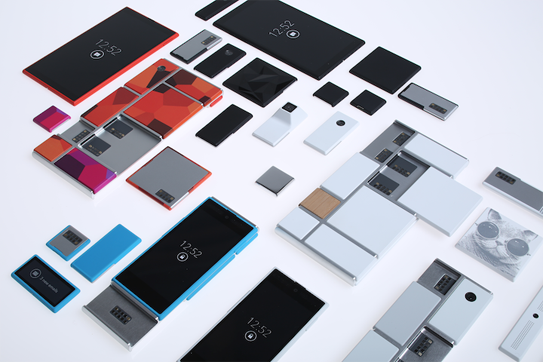
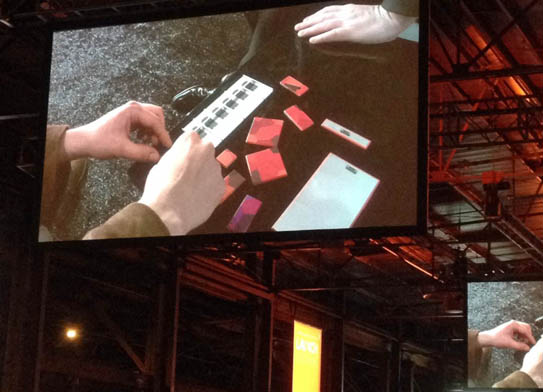
2. The Cardiovascular Innovation Institute’s 3D Printed Heart
We can 3D print a superior human heart. And that is ‘the easiest organ to bioprint‘. You should be able to get yours within the next 5-10 years. Mind, blown. The app startups that took the stage thereafter suddenly impressed less by the minute.
3. Knightscope’s K5 Autonomous Robot
He predicts and prevents crime. And he’s scary to your privacy, but there is no doubt you will meet K5 soon, and he might just save your life. Lose your privacy, have your life saved. A risk worth taking?
Below you can see a graphic showcasing 20 of the 40 companies that launched at the festival this year and (if you have really good eye sight) the money raised by attendees in the short 3 days for each, outside of the added funds during the final ceremony. Very few of them will have lasting impact, but as Jason put it prior to announcing the award winners, no one, not even the judges really know who of them will turn into the next WhatsApp, SnapChat…or Dropbox, which was not deemed worthy an award at Launch a couple of years back.
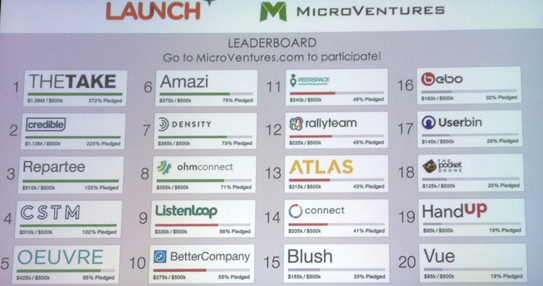 Launch walked the walk, the money talked the talk, and all of it happened while the many homeless outside the venue had no idea that they too will see the benefits of what Jason has put together. They just saw the Teslas pulling out of the lot.
Launch walked the walk, the money talked the talk, and all of it happened while the many homeless outside the venue had no idea that they too will see the benefits of what Jason has put together. They just saw the Teslas pulling out of the lot.
See you next year at Launch. Call me on my Ara phone to Connect.
CATEGORIES: Blog Startup Advice
Tackling Your New Brand’s About Page: 4 Tips On How To Say Less, Edit More, And Make It Resonate
I was born in Austria. English is my second language. Yes, I write a lot, but I do it because I want to share my expertise, not because I believe that I am a great writer. Yet today I set out to blur the lines of copy writing, branding, enthusiasm, content strategy, your target audience and content overload. Launching your brand puts an emphasis on the About section of your web site, no doubt about it. Even if you have a video and to-the-point messaging on the Landing Page(s), the About page will be sought-after. It needs to explain the following in a swift manner:
- What you do (Mission/Product Or Service Intro)
- Who you do it for (Target Audience)
- How you differ (Differentiators)
- Why I should care (Connect Emotionally/Value Proposition)
- What I should do next (Call To Action)
That’s a lot to convey on a single page and therein lies the problem for an enthusiastic entrepreneur who writes this important piece of content in a stream of consciousness (it is after all the subject you know best), then quickly proofs it, and by the push of a button publishes it. Rarely do they look back. Yet another item checked off the busy to-do list. Then the journey of marketing and metrics hits in and the About page, long forgotten, is like ‘a ghost employee’ in a well functioning company; it lives on yet it should have been let go and replaced a long time ago.
I know this feeling well. I see it on a nearly daily basis with our new clients, but I also fell victim to it myself. Here are my top 4 tips on how to go about deriving your About copy:
1. Find A Time And Place
It has to be right. You can’t just block off an hour on your busy calendar. It has to be more like that moment when you drive to the beach to just sit and breathe and think big thoughts. Make the time for that moment and don’t put a time limit on it. For myself that moment arrived during a 12 hour flight after I have answered ‘all’ E-Mails and there was no WI-FI for new ones to trickle in. I watched the Steve Jobs movie (Inspiration 1), had a glass of wine (Inspiration 2), the cabin lights went out so everyone could sleep (I was in Coach – Inspiration 3), and I knew if I started writing now that I had hours and hours to fine tune and contemplate. And so I did – the time and place were right. Best of all, even if I wanted to, I could not just push it live as I did not have WI-FI, so it forced me to sleep over it and make even more tiny edits when ‘back on the ground.’ It took me 3 hours to write.
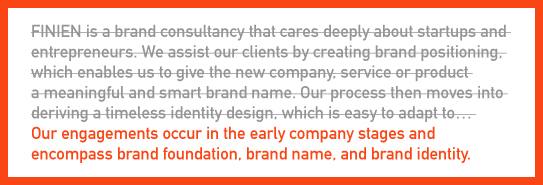
Edit, edit, pause, then edit some more.
2. Think In Words, Not Sentences
Words should not come easy (Ask F.R. David, he knew). If they do, consider it a brainstorm exercise, then work on a synopsis of that copy. Don’t cut paragraphs, don’t review sentences, dive deeper and focus on it word-by-word. In the end your About copy should be thought of as a lineup of tag lines, because in a tag line every word counts, has meaning, adds to your brand story. Think of each word as a strategic component to the whole.
3. Read It Like They Would
Once you feel you phrased it in just the right way, make sure it will resonate with them. Sounds logical, hence easy, but it is one tough role play: Write in an emotional and enthusiastic manner that conveys your brand’s soul, but then read it from the perspective of your target audience. It helps when you created target personas, that way you can read pretending you are that specific person. If time allows, run it by your target audience and conduct a mini focus group, or even A/B testing of different About pages, to see what sticks.
4. Edit, Then Edit Again
Make it as simple as possible. Make it as short as possible. If you need to, add links to further content below your CTA (Call To Action). No one reads a long About section. No one. Rather go through steps 1-3 and then edit it down again and have something your audience will actually be compelled to read, because it is short and approachable. This is about getting them excited to keep going further, to click deeper, it is not the page that needs to convey everything, but ensure it has the 5 components listed above embodied.
In a study of user tests it was discovered that users with higher literacy levels also fared better on web sites written for a lower level literacy audience. So keep it brief and keep it simple. I guess I should go back and edit this post, but I don’t feel too bad keeping it this length as someone just released the book ‘Brief: Make a Bigger Impact by Saying Less;’ it spans 256 pages.
CATEGORIES: Startup Advice Your Brand Launch: Digital
How Oversharing Creative Options Will Hurt Your Brand (On Hand of The Worst Magazine Cover Design of 2014)
When I was 8 years old I started ‘a publishing house’. I named it Buttersemmelweich Verlag. A real memorable name, right? It translates to ButterBreadSoft Publishing Co. It only published a single magazine, but over the course of several years. It was called SNOOPY. Go here for a stunning visual I dug out from the family archives just for you. Please note the Nike logos on Snoopy’s shoes, a sign of innocence lost and a hint of my future in branding. Perhaps the Charles M. Schulz Museum (which I can highly recommend a visit to) will sue me for the 6 issues I sold – yes, the young entrepreneur that I was I actually asked my family members to pay for my work. Just like a retainer, each issue I drew and wrote was copied 6 times (by my mum) and always sold out (to my mum Etc). As I grew a year older the name of the magazine was changed to JoeCool, an obvious transition, and I brought on ‘a partner’ as one ought to do, especially since I could not use the typewriter yet. My fascination with magazines grew over the years. As a young communication designer I felt the need to be on the forefront of pop culture, to be informed about as many topics as I possibly could in a swift and constant manner, while being surrounded by the freshest fonts and layouts. Since the internet has not quite been as giving back then as it is today, buying as many magazine subscriptions as possible was my goal. I have since adjusted my subscriptions, but have not kicked the habit. Needless to say, I have seen (and over the years also professionally designed) plenty of magazines.
As I descended into the current issue of Bloomberg Businessweek a couple of evenings ago, I was shocked before I could even flip to Page 2. The cover was bad. It was so bad that it was actually appalling to me. Judge for yourself:
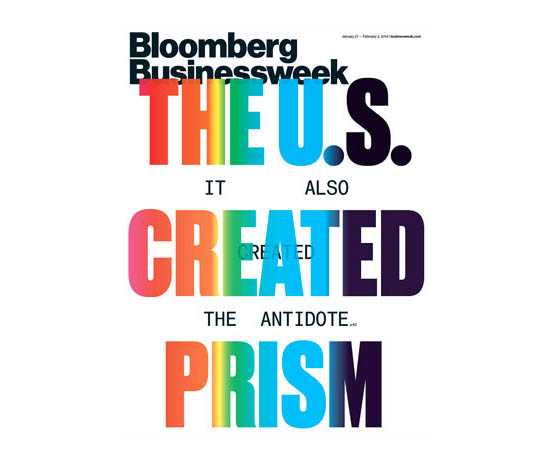 I was shocked, not a bit intrigued, only shocked, and a little sad as Bloomberg Businessweek has been pushing its design steadily after its acquisition in 2009. Conceptual, socially challenging and often shocking cover designs were part of their re-branding. But this cover is just shockingly bad.
I was shocked, not a bit intrigued, only shocked, and a little sad as Bloomberg Businessweek has been pushing its design steadily after its acquisition in 2009. Conceptual, socially challenging and often shocking cover designs were part of their re-branding. But this cover is just shockingly bad.
How did it happen and why would you care?
Bloomberg Businessweek shares the story on how the covers were conceived in each issue, on Page 2, right next to the index, a prime location for any magazine. So here it goes:
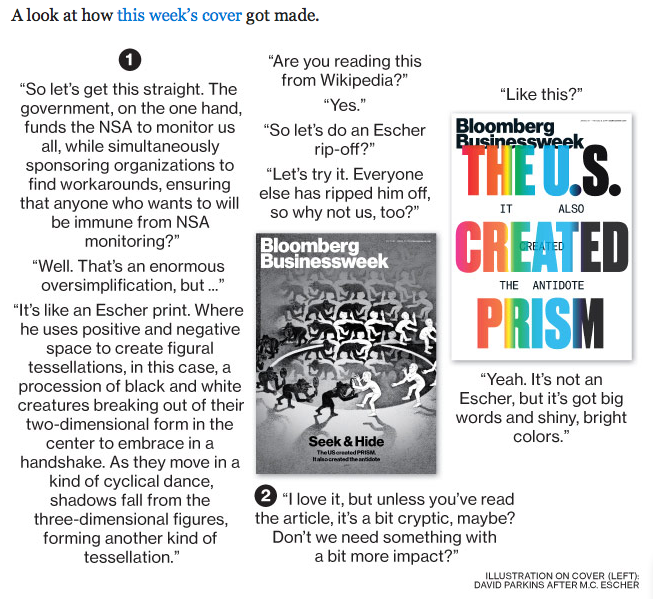
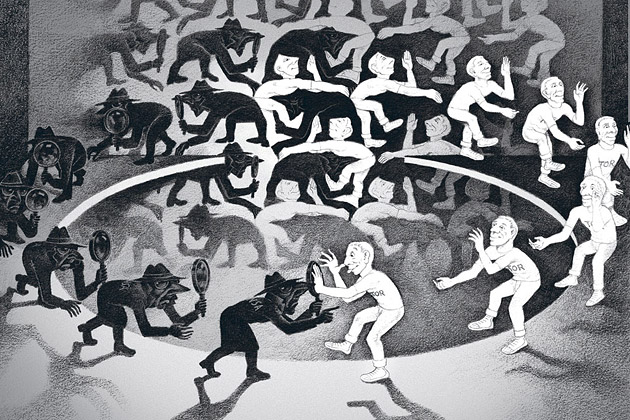
Image Source: Bloomberg Businessweek
Yes, indeed they talk about ripping off MC Escher – and may I add that the original design (above) also has a touch of Spy vs Spy ‘borrowing.’ Alright, I registered that as a bizarre strategy statement, but going from a solid conceptual and surely intriguing (yet copied) design to a horrendous – ‘at least it’s got big colorful letters’ – solution makes it obvious that the chosen design option only made it to the cover in a rush to meet print-deadlines (imagine how long the Escher illustration must have taken to create?).
As the reader, a consumer, the target audience, do you see the problem? Sharing both designs and the decision criteria is a very bad brand decision. If the cover design is genius, Bloomberg Businessweek’s story on how it was made is only killing the magic. No room left for imagination. Even worse, we can see how bad the other cover design option was, making the amazing design option that much less great as we want to feel designs go from good to better to great. If the design is really bad (as it is in the current issue) and the option that did not make it would have been significantly better (as was the case in the current issue), the reader is upset and disappointed by Bloomberg Businessweek’s choice. This is obviously not good for a brand and I see this as an open letter to Bloomberg Businessweek to change its strategy and to use this Page 2 real estate for something that works for, instead of against, its brand.
As an entrepreneur, never share your design options with your audience at large. It’s tempting as they are the ones that will need to buy (into) it. If you really don’t trust your brand or design consultants, have a small and narrow focus group, if you must, but do not share design options with your entire audience. Not during, and definitely not once they have been made. Most everyone who did not go through design college tends to screw this up big time. Look at Marissa Mayer’s big fail when introducing the public to Yahoo!’s logo re-design last year. Everyone got excited, everyone had their favorites, and then…a universally disappointing final choice.
The habit of sharing creative options is one of over sharing, or TMI as one would text. Don’t fall into this invitingly open trap as your audience’s TMI feeling would very quickly morph into an OMG and a WTF (Excuse my language) expression on your end. Spare yourself, and your brand that pain.
The Leaf Blower Syndrome
I am not sure about you, but I can not stand leaf blowers. The concept does not work for me in any way.
Now if you live outside the US, or in a region that has sane laws restricting or prohibiting the use of such evil devices, you may not know what I am referring to. The concept is simple: Leaf blowers use high pressure air, like a fan or hairdryer on steroids, to move leaves from one area to another, most often this means your gardeners blow them to your neighbors, or onto the street. Problem solved? Not quite. Either your neighbor hates you now (even a bit more), or the wind blows them back to you, eventually. Solution? Have the leaf blowers come by more often.
Now that I filled you in, let’s do this again:
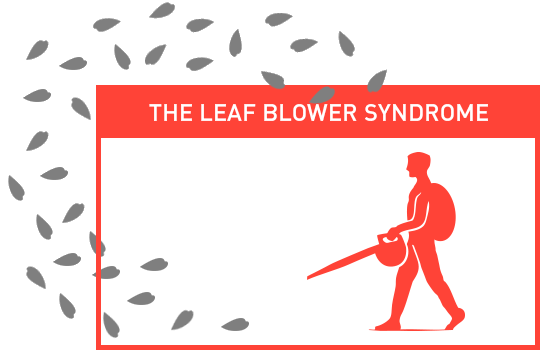
The Leaf Blower Syndrome: Brand Identity of Startups
Leaf blowers postpone an issue, while displeasing everyone who gets in touch with them. It stinks up the neighborhood, is annoyingly noisy and pushes a problem from one place to another. Bingo! Out of sight – out of mind. Now that was quick and cheap. Consider those massive amounts of leaves handled.
On my way to our office last week, my thoughts deeply entrenched in the world of branding (as you’d expect), leaf blowers pushed their leaves smack onto a busy street during rush hour traffic. As I passed them I saw those leaves go absolutely everywhere; mostly right back to where they came from. It made me think of all these startups saving money bootstrapping (Hint: ’99 Designs Dot Com’) – now read these two words carefully – their identity by crowd sourcing it to strangers to create cool designs. They will not arrive at a solution easily, so they get more leaf blowers to work faster and more often creating vast amounts of different logo designs, spending hours over hours discussing the designs they receive in their Inbox until they need to just pick the one they ‘like’ best.
A couple months later early brand adopters gather and success hits. The wind has changed, the leaves are coming back. This is the point in which they realize that the logo is not their real identity. It does not connect. It is missing meaning. It does not have nor create a story. They need to re-brand, even though they just spent all that time and energy, and by now even a sizable expense. And this time it is going to be much more costly then had they done it right from the get-go. They have to re-educate their customers, hire a specialist whom they pay professional fees like they do with their other consultants. They need to re-create all touch points from the web site via all the collateral to perhaps even the signage. It stinks.
If you ask successful startups what they would have done differently in retrospect, many say they wish they had not cut costs on their initial branding or web site efforts. The wind changes, the leaves come back, but at that point the neighbors already like you that much less and making up is hard to do, a much lengthier process that involves other ‘leaf-behinds’ (sorry, I just had to!).
I recall my parents picking up leaves in batches in our garden and carrying them to the compost to get rid of them. Now that makes a whole lot of sense. It definitely was a time investment, but only a one-time investment. It even had a romantic part to it. It showed they cared and that the seasons were changing.
Pick up the pieces, make sense of them, do it with love, and it will show. Just remember, it’s your startups identity.
CATEGORIES: Startup Advice Your Brand Launch: Identity
Personal Notes of Inspiration For 2014
What drives you as an entrepreneur? A question all of us get asked a lot, and one that we ponder especially during these last days of the year where we look back and analyze. We try to learn from our mistakes and make sure to celebrate our achievements, all whilst looking ahead into a new year with the plan to accelerate and prosper, our companies as well as ourselves personally.
This inspiration to keep pushing, to uncover solutions, to assist others and to turn into better human beings, or brands, comes from strange places: nature, arts, (mostly silent) sports, science and fellow human beings. Each and every one of us picks their favorite source of inspiration, and over time, after our 20th marathon or 10th Art Biennial visit, we realize that it is what informs our work. In a subliminal manner, but one that once realized can be analyzed and traced right back to those often addictive and slightly obsessive personal journeys deep into a matter that is far removed from our professional area of expertise and work place.
Today I share mine with you, knowing all too well that personal obsessions are ill-advised to be shared with large audiences, as they are odd and, well… personal, but by me doing so, I hope to inspire you to stick to that thing you do that takes a lot of your time away from your work, your family and friends, yet you need in order to keep being inspired, and to keep inspiring others.
2013 ReVisited is this obsession, my labor of love; a carefully curated selection from 5,315 musical tracks released in 2013 that found their way into my collection, which means I listened to an album and a half every day of this year. I then compiled the best tracks into a monthly curated podcast called PreVisited. This compilation showcases the best of those podcasts. It represents my personal journey through the music that was released this year and it might even turn into your soundtrack of 2014. You will rediscover electronic music pioneers (OMD, Depeche Mode) and all-time greats (David Bowie, U2), while getting to know artists you may have never heard of (Mt. Royal, Charley Bickers, Jont). You will find songs that belong to each other, creating perfect sequences in voice (Lorde & Emiliana Torrini) or music (Phosphorescent & Mt. Royal) and if you stick around long enough you get to explore German rap poetry (Thomas D, Xavier Naidoo). I hope you will find some new favorites, or at least enjoy this eclectic journey through the past year in music, while thinking about what it is that gets – and will keep getting – you inspired.
Thank you for following the New Brand Post, for stimulating my thoughts on branding and for absorbing them on a weekly basis.
Let‘s rock 2014!
2013 ReVisited (The best of a year in music) by Fabian Geyrhalter on Mixcloud
CATEGORIES: Blog Startup Advice
Building Your Brand From The Ground Up (A Fireside Chat With Yours Truly)
A couple of weeks ago, Bob Garlick, host of Business Book Talk (poking through below), contacted me to schedule an interview about our book ‘How to Launch a Brand.’ With Bob sitting in Vancouver and myself in Los Angeles, I was immediately taken by surprise as there was no script that he shared with me, no canned answers to prep, no warmup chatter and no edits were made to our conversation.

The result is an honest and stimulating conversation between two individuals with a keen interest in design, branding and entrepreneurship, which I’d like to share with you. Below audio not only gives you a peek into our book, but also covers topics such as misconceptions of branding, brand strategy, how brands need to be different than 15 years ago and how to connect with your customers through branding:
Audio clip: Adobe Flash Player (version 9 or above) is required to play this audio clip. Download the latest version here. You also need to have JavaScript enabled in your browser.
(Can’t see above audio player in your E-Mail? Please listen to the audio via our site)
Now that I crossed the bridge by posting audio (how adventurous), I might as well share a quick video in which I further define ‘brand’ specifically for startups, filmed at a mentoring session (how advantageous) at the Founder Institute in San Diego two weeks ago.
‘Tis The Season of Giving Thanks: Employee Holiday Incentives VS Restrictive Startup Cash Flow
I spend my days talking about early stage branding with startups and I learn a lot about their behaviors, struggles, fears, and of course their amazing energy and innovative mindset that I thrive off. At times I will use the New Brand Post platform to discuss startup culture and give entrepreneurial advice. It will save you from getting brandexia (a sudden sensation of anxiety caused by the over consumption of the word ‘brand’ by entrepreneurs, often leading to serious cases of brand self-awareness), while still gaining actionable insights and advice for your early stage startup.
As the holidays are approaching (Happy Thanksgiving to my US-based readers), so are company parties, chatter about Q1 goals, and speculations about holiday bonuses. Let me start off by saying that cash-based holiday bonus incentives are a wonderful thing, no doubt about it. I always love giving as well as receiving them thoroughly. Employees appreciate the gesture of appreciation and the fact that they may be able to plan a trip or buy some gifts they otherwise might not have had the opportunity to afford easily. But people investing their time and talent into a new venture understand that cash flow is one of the keys to the survival of the venture, that cash needs to be put to work in small chunks and in strategically calculated places that will directly impact the company’s growth (and yes, brand). Most early stage startup employees are very aware that they made a commitment to give up some traditional monetary perks for being part of the startup tribe, for investing into their future.
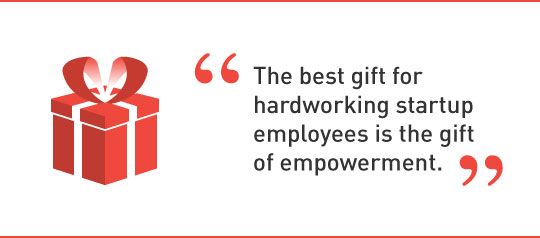
As a founder of a new cash-strapped venture, the most cost-effective and best gift for hardworking employees is the gift of empowerment. Create public awareness of staff by talking about their valuable insights and specific contributions they made to the company, publicly via a blog post or newsletter with the title ‘The Season Of Giving Back To Those Who Gave (Your Company Name) Their Best in 2013‘. Mention each and every one of them with specific insights they provided, or actions they took that moved your company forward, full names and photos included. If you have more than 8 employees, spread it out through the month of December. Share it via Social Media and tag them so the article shows up in their networks signifying that this is not out of self-interest, but pure thanksgiving.
Instead of giving a low (= insulting) cash bonus, or a gift that may or may not resonate with your staff, try honest public praise and let me know how it is being perceived. I bet they will thank you, sincerely.
CATEGORIES: Blog Startup Advice
